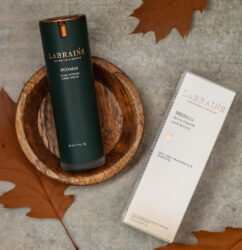Since our daily lives are connected to digital devices – smartphones, computers, and LED TVs – there is more and more talk about the negative effects of blue light or HEV (High Energy Visible light) on the skin.
Although the research is still new, and we are not yet fully aware of the effects of blue radiation on us, which we may only learn in years to come, it is worth thinking about it and being careful. For example, the fact that UV rays cause malignant tumours was discovered by researchers many years after the rays themselves were discovered, but although there are many studies, there is still a vast amount of the unexplained that gradually emerges each year (1).
So far, concerns about the effects of blue radiation on our health have been raised by eye specialists, citing cataracts, glaucoma, and other eye diseases (2). Therefore, special glasses were created for this purpose. However, dermatologists also emphasize that blue radiation is bad not only for the eyesight but also for the skin.
The Sun is also a source of blue light, and in optimal doses we need it to feel alert. Blue light helps to overcome certain types of depression, regulates our circadian rhythm, and improves cognitive abilities (3). However, if our daily life is related to working at a computer and looking at smartphones for a long time, it will undoubtedly have consequences.
You’ve probably noticed that after several hours at the computer, the skin on your face, especially in the eye area, looks tired. When we focus on the screen, we don’t notice how we strain our eyes, often tightening our skin. It is no coincidence that experts recommend that those who spend a long time at the computer leave it every 40 minutes and rest for at least 10 minutes. It helps not only the eyes, but also the back and, of course, the facial skin. Ideally, when performing any eye exercises, move your arms and shoulders. This will not only help tense muscles, but also promote blood circulation and oxygen access to the skin.
But what are dermatologists so worried about? Recent research shows that blue light rays have serious effects on the skin. They tend to penetrate very deeply – even to the hypodermis. Dermatologists refer to studies that cause problematic skin that is affected by purulent pimples and is exposed to blue light for a long time. Due to the emission of blue light, free radicals are formed in the skin, it suffers from oxidative stress, which damages cellular DNA, promotes skin inflammation, damage to collagen and elastin fibers, as well as the pigmentation already mentioned (4). In addition, it all accelerates skin aging.
To protect the skin from blue light, UVA / UVB photo-aging, LABRAINS has developed several products, but we would like to highlight our BB cream with a special formulation, available in two shades – olive and light undertone. More about the product: https://labrains.eu/en/product/35/bb-krems
What can we do to protect our skin from blue light?
- Spend as little time as possible on digital devices.
- Reduce the brightness of the screen or turn on the blue light filter, wear special glasses.
- Use the hands-free system as often as possible and do not keep the computer turned on unnecessarily.
- Avoid using smart devices before going to bed so as not to affect the quality of sleep, as blue light reduces the levels of the sleep hormone melatonin in the body, and melatonin is known to be the beauty hormone.
- Choose special care and decorative cosmetics that protect the skin from UVA / UVB and blue light rays.
- Regular outdoor activities as much as possible.
References:
- T. Baban, Y. Kamenisch, W. Schuller, A. von Thaler, T. Sinnberg, J. Bauer, G. Metzler, C. Garbe, M. Röcken, M. Berneburg, 465 Ultraviolet (UV)-A irradiation induces melanoma invasion via enhanced Warburg effect, Journal of Investigative Dermatology, www.sciencedirect.com
- Annadata V. Rukmini, Dan Milea, Mani Baskaran, Alicia C. How, Shamira A. Perera, Tin Aung, Joshua J. Gooley, Pupillary Responses to High-Irradiance Blue Light Correlate with Glaucoma Severity, Ophthalmology, www.sciencedirect.com
- Barbara A. Murphy, Mary M. Herlihy, Margaret B. Nolan, Christiane O’Brien, John G. Furlong, Stephen T. Butler, Identification of the blue light intensity administered to one eye required to suppress bovine plasma melatonin and investigation into effects on milk production in grazing dairy cows, Journal of Dairy Science, www.sciencedirect.com
- Kade D. Walsh, Erica M. Burkhart, Atsushi Nagai, Yasushi Aizawa, Takamitsu A. Kato, Cytotoxicity and genotoxicity of blue LED light and protective effects of AA2G in mammalian cells and associated DNA repair deficient cell lines, Mutation Research/Genetic Toxicology and Environmental Mutagenesis, Volume 872, 2021, www.sciencedirect.com









